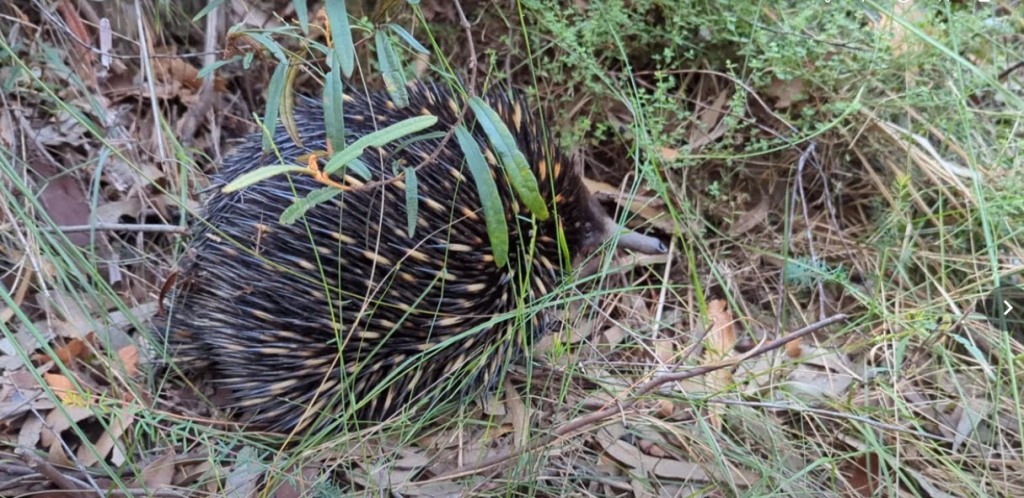Category Archives: Not a bird
Swamp Wallaby in the flowers
A few days ago in Manly Dam park, I saw this sweet little wallaby on a hillside covered with pink flowers (Boronia). In recent weeks, there’s been a wallaby on this hill each time I’ve passed by. I don’t know if it’s the same wallaby, but I’m thinking maybe it (or they) like the flowers as much as I do.
Swamp Wallabies are a type of small kangaroo (macropod) found in eastern Australia. They’re dark grey in colour, with rust-red fur around their ears and chest particularly during breeding season. They’ll hop away as you approach, then turn round and watch you from a safe distance.
Although this is primarily a bird blog, I’ve published a few other posts about wallabies too!
Python has just swallowed a meal
A few days ago, I saw this Diamond Python on Manly North Head near Sydney. The snake has recently had a meal, hence the thickening in part of the body. I’ve drawn a rough outline in a copy of the picture, so that you can see the shape of the snake more clearly.


The snake’s head is resting on its body near the middle of the picture. The snake lies mostly straight, with just one bend at the bottom of the picture. It’s well camouflaged, even though it’s lying out in the open to bask in the sun and digest its meal.
Diamond Pythons are just one of several types of pythons found in Australia, and are native to south eastern New South Wales. They’re large snakes, growing up to three metres long. They aren’t venomous, though they do have teeth and can bite. They lie in wait for their prey, and kill it by squeezing it to death. They eat the animal whole, then digest it once it’s inside their stomach. That’s what’s made the large bulge in this particular snake.
If you’d like to hear the story of another of these snakes, take a look at a Diamond Python in a Banksia tree.
Spider wasp in my house
Warning: This blog post could be scary and off-putting. Nothing bad happens to me, but by nature the wasp isn’t very nice to the spider.
Not a bird in sight, but a bird would definitely have found this sight interesting. A large, red wasp appeared in the room where I was sitting. It flew around a bit, then disappeared. A minute later, it re-appeared and dumped a paralysed huntsman spider at my feet!
The wasp is called a “spider wasp”. I think this particular variety is a tarantula hawk wasp. It injects venom into a spider, often a huntsman, which paralyses the spider. The wasp then drags the spider into its nest and lays eggs inside the spider. When the wasp eggs hatch, the larvae feed off the spider.
Now, if you’ve ever seen a huntsman, you’ll know that they’re not small as far as spiders go. I’ve seen wasps like this one in the garden, sometimes performing amazing feats with a spider in tow. One wasp crawled a vertical rock face, several metres high, dragging a spider behind it.
Fascinating as these creatures are, I didn’t really want a wasp nest with a paralysed spider as food source in my house. I feel bad for the spider. Plus, tarantula hawk wasps evidently have an extremely painful sting.
While the wasp was still pre-occupied with the spider, I managed to cover both with a large beer glass. This photo shows the wasp with its feet still partly holding the spider:
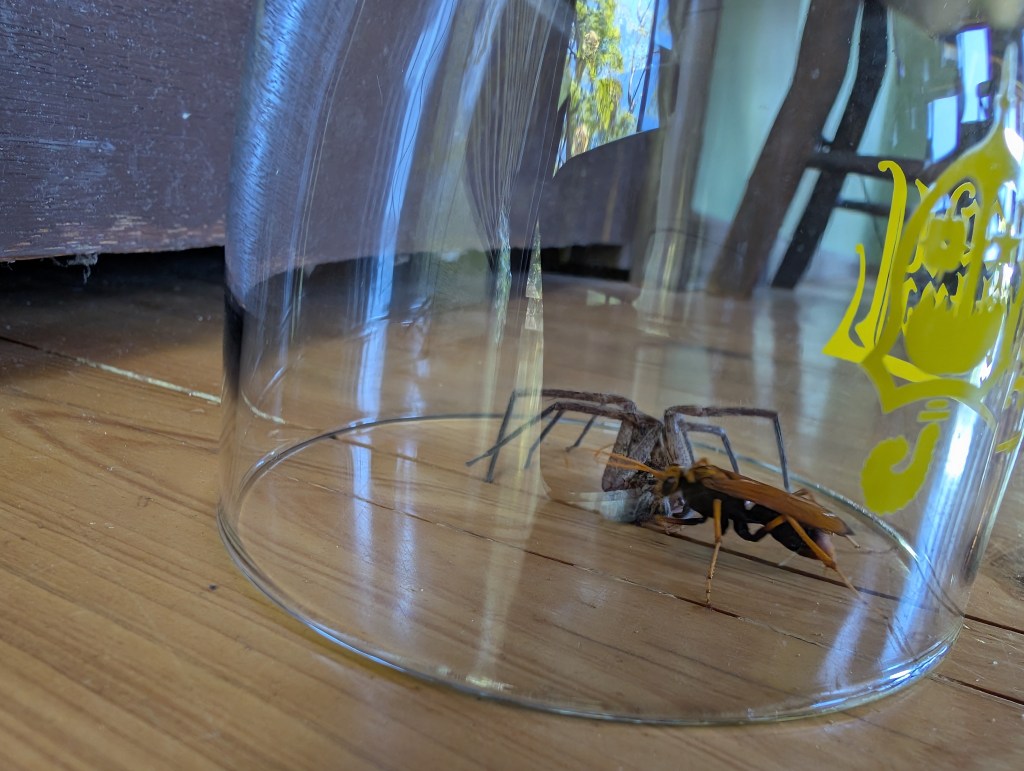
Immediately, the wasp started prowling around the edge of the glass. This photo is clearer than the one above, and has my husband’s finger for scale:
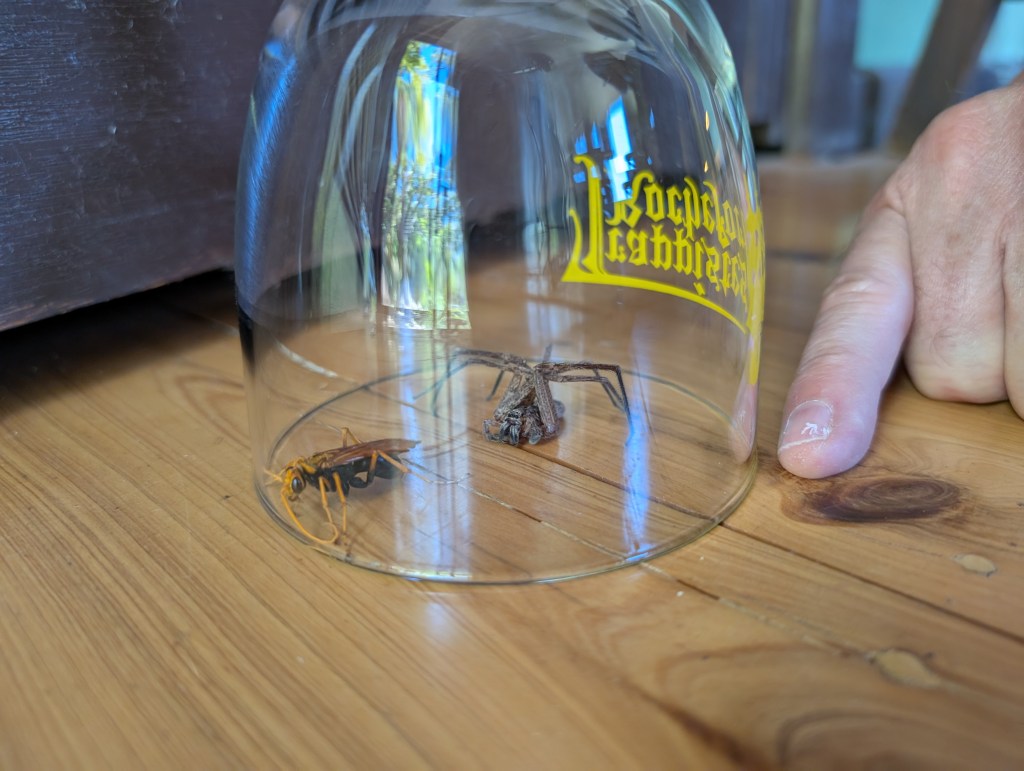
Look at that poor spider’s eyes.
We’ve had other types of wasps in the house. They come in, fly around and inspect the walls, and with any luck fly out again. Sometimes they decide to build a nest. The most common wasps that we see are dark in colour, of medium size, and build cocoons of mud to house their eggs. It’s quite astounding to see how fast they build these constructs. But I do draw the line at tarantula hawk wasps.
Wait for it! Echidna emerges from the undergrowth
Echidnas are egg-laying mammals found in Australia. Along with platypuses, they’re the only mammals that lay eggs. They look like a cross between a porcupine (long quills) and an anteater (long nose). At approximately 50 centimetres long, an echidna is about the size of an anteater too.
Occasionally, I’m lucky enough to come across an echidna when I’m out walking in the bush near Sydney. The most recent one was just a few days ago, in Manly Dam conservation area.
This video shows the echidna pushing its way out of the undergrowth. I heard it rustling in the long tufts of grass, and got my camera ready. The little creature waved its nose in the air to check for danger, then decided it was safe to cross the patch of bare ground in front of me.
Biggest Yabby I’ve ever seen
A Yabby (Cherax destructor) is a freshwater crayfish found in Australia. I’ve seen a couple of them when I’m out in the forests of New South Wales, but the Yabbies I’ve seen up to now were quite small: about the wide of two fingers, and about as long as my longest finger.
Yesterday, I was strolling along a path at Manly Dam, NSW, when I heard a loud rustling at foot level. I looked down and saw a huge black Yabby. It saw me at the same time, and raised its front claws in a defensive position:
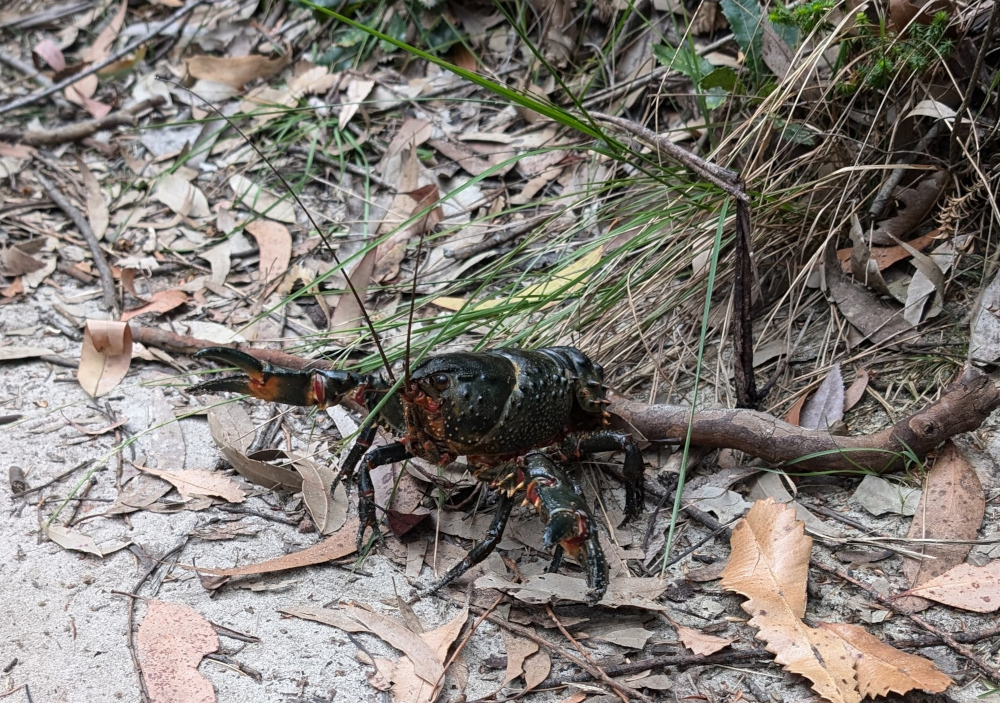
Look at those enormous spread claws and that knowing eye! By my estimate, the Yabby was 20 cm long and 4 cm high, and the spread of the claws was about 20 cm.
We gazed at each other for a while, then I carefully stepped over and past the creature. It immediately started retreating backwards towards the footbridge that I had just walked over. I’d been in the way of its getaway. Here’s a picture taken from my video of the retreat (coming up next), to show the scale of the Yabby alongside the footbridge and path:

This video shows the Yabby’s retreat:
If you’re walking along a bush path near fresh water in Australia, and you notice some large holes in the ground, they might be made by Yabbies. (Or by spiders, snakes, ants, etc —you know the story!) Evidently Yabbies got their scientific name, Cherax destructor, from the damage they can do to farmland.
Birds such as cormorants and ibis do eat Yabbies. So do people, large fish, other Yabbies, platypus, and rats. I think most creatures, apart from people, would have quite a fight with this particular specimen though.
Amazing wrap-around spider
When I approached my car the other day, I saw a patch of something on the door handle. “Bird dropping,” I thought, and was about to wipe it off. Then I noticed that the blotch was symmetrical. Uh oh. I looked more closely. A spider, and a real cutie. I’d have been devastated if I’d hurt it.
This is what it looks like when zoomed in on my camera:

The spider has wrapped itself around the door handle, to be as flat and inconspicuous as possible. The photo above shows the body of the spider. Its head is below, mostly hidden from view. The colours and patterns on the body are amazing. I think they’re enhanced because it had been raining and the spider was wet.
Here’s a picture with my hand and the keyhole, for scale:

I took the above photo the day after the first one. Yes, the spider was still there. It was dry this time, and therefore less colourful. And it had moved from the top to the bottom of the door handle.
Here’s the spider’s face, viewed from underneath the door handle:
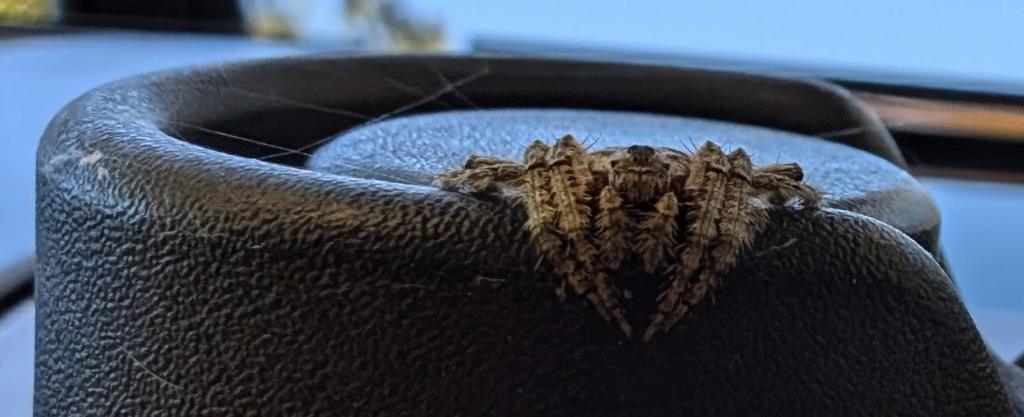
And here’s as much of the head and body as I could get into one shot:

Wrap-around spiders (genus Dolophones) have a flat, curved abdomen, so that they can wrap themselves around branches. This makes them good at disappearing into their surrounds. They build an orb web every evening, and destroy it each morning. I guess those strands of web on the door handle are the remains of last night’s web.
Since the spider had been on the door handle for two days, it looked like it had taken up residence. I don’t think spiders and door handles are a good match, so I persuaded the spider onto a leaf and moved it into the nearby shrubbery:

Green huntsman spider
Up to now, all the huntsman spiders that I’ve seen have been brown. Some were darker, others lighter, but basically brown. I was surprised to see this little one the other day:

It was quite small, for a huntsman, but still a good size spider. In real life, it appeared even more green than the photo shows. I had to Google it, to discover that indeed, green huntsman spiders are a thing. This one was in Allambie Heights, north of Sydney, NSW. I hope to see it again!
New website ready for more birds!
This bird blog has moved to a new address! You can now find the birds and me at sydneybirder.com. Don’t worry — if you go to the original birdsinsydney.wordpress.com, you’ll be redirected to this site. All the birds and readers comments have moved here too.
Did you notice some advertisements interrupting the bird pics in the past? Through the magic of commerce, the ads have disappeared now too.
Happy birding!
Plant Hopper on my window
(Not a bird, but probably of interest to birds as well as birders.)
A couple of days ago, this tiny little creature appeared on my window pane:

The creature is tiny (a few millimetres long), it’s on the inside of the window pane but on the other side of a gauze netting that we use to keep the insects out, and it’s in silhouette because of the light coming in from the outside. I was pleased that my mobile phone’s camera managed to get any shot at all.
After a bit of research, I think the creature is most likely a Plant Hopper — my best bet: the Passionvine Hopper, Scolypopa australis. Alternatively, it could be a Leaf Hopper.
The creature moves in a strange way. It’s wings remain entirely still, and the whole creature kind of glides across the surface:
It’s odd how the wings appear to be transparent ovals, with what looks like other wing patterns imprinted on them. At one point, the creature made a short, very quick jump from one spot to another — so quick that I didn’t see the movement. I just saw that it had gone from one place and appeared a few inches away. I didn’t catch that movement on video.
This shorter video shows the creature moving more slowly:
If you have a positive identification or know more about this little insect, I’d love to hear it.
Echidna convinced I’m gone after just a couple of seconds
Walking early one morning at Manly Dam near Sydney, Australia, I came across this Echidna. They are cute, adorable animals that don’t seem to have a care in the world. Whenever I come across one, it quickly buries its nose in a bush (hiding!) But if I wait just a few seconds, the animal is convinced that I’m gone. It comes out of hiding and continues its casual amble.
Echidnas are mammals, about the size of a fat cat. They look like a cross between an anteater, a porcupine, and a small bear. Echidnas and platypuses are the only mammals that lay eggs.
This is a short-beaked echidna (Tachyglossus aculeatus), which is the only living type of echidna found in Australia. There are three other types, which live in New Guinea.
They have long, very tough noses that they stick into the ground in search of ants and termites. If you look carefully at the start of the video, you can see the animal’s eye and the rather strange-looking nose.
Here’s a still picture, taken from the video:
